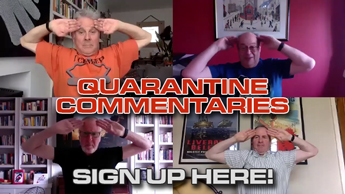 |
Ice Cold Penguin In the final part of Gil Taylor's interview with Mr Flibble, the penguin probes him about his approach to cinematography and his relationship to master of suspense and founding father of modern cinema, Alfred Hitchcock... |

Andrew Ellard
Mr Flibble prompted Andrew to ask about Gil's memories of his times in FILM STUDIOS.
The film studios used to stink like nail-polish, acetate or acetone, and the film itself used to smell, and it was like pot. Once you got this stink down you, the influence was incredible. You couldn't wait to get back to smell the acetate or acetone - it was like a drug up your nose!
Did you have a priority that you kept in mind, an APPROACH to lighting you always stuck to? (Mr Flibble hinted at the prioritising of flightless birds...)
I've always thought the most important thing on a film was the acting and the actors, so I concentrated on actors. Every film you see of mine, you don't have black holes for eyes and heavy shadows all over their faces - [they are] beautifully photographed in the mood that they should be.
I was dedicated to building performances, which today is forgotten by most people. Especially television - they don't give tuppence about anybody's face, and neither do the boys and girls coming out of these schools. They're given two-penneth worth of dustbin lids with photoflood bulbs in! Where[as] if I wanted 40 brutes I'd have 40 brutes.
When I [worked on] Ice Cold in Alex (1958), I took five small generators, and each one had a brute on, and each one had a dedicated man. So wherever we were, on hill or anything, I always had these brutes. So when you see films like Ice Cold in Alex people say, 'Why is it that it's so beautiful and soft?' Well that's why - because I was always able to use this lamp.
You worked with ALFRED HITCHCOCK on Number Seventeen, before you were a cinematographer and he had a reputation as something of a joker. Was that true?
He used to put Ex-Lax in the coffee and then lock all the doors. He was terrible. He used to get the women out of the way and put two or three great spoons of Ex-Lax in the coffee. And they'd say, 'The coffee tastes a bit funny today.' He'd put Ex-Lax in to give everybody the shits. He did all sorts of terrible gags in those days.
Hitchcock had a habit if a VIP came in. Everybody wore beautiful Italian ties in those days; silk, if they were anybody. And his habit was [that] there'd be an accident - all the lights would be switched off. He had a very sharp pair of scissors, and he'd cut your tie off! Nobody knew at the time. And they'd go off with half a tie and everybody laughing. [Hitchcock] always wore a blue silk tie and a white shirt. So [a friend] and I said, 'We're going to get that bugger's tie.'
In those days the film was Pan Type 2 - which wasn't grey-backed, it was a light film - and it had a piece of sticking material on its side, and when you took it off there used to be a flash of light. This caused a bit of static, and Hitchcock always used to moan about the static.
So anyway, somebody came on and said, 'There's static on the rushes!' And he said, 'Oh my God, how has that happened?' I said, 'Well Mr Hitchcock, if you come and see we'll give you a demonstration.' He said, 'Oh, I think I'll do that my young man.'
So anyway, he came through, it was a darkroom. As he came through I managed to cut his tie off! About two hours later - I'm back on the floor [by] then - he [was saying] 'Christ! How did this happen?' He didn't know - but he said he'd fire whoever did it.
Mr Flibble said he once made Craig Charles an apple pie bed. Andrew tutted and asked Gil if he confessed when he worked on Hitchcock's final film, FRENZY (1972)...
When I went to [the] interview [with] him at Pinewood years later, he said, 'Would you like to do my film?' I said, 'Before I say yes, perhaps you should hear what I have got to say. Do you remember when you used to cut people's ties off?' He said, 'Yes, very well.' I said, 'Do you remember when you lost yours?' He said, 'Yes, I never did discover who did that.' I said, 'Would you have fired them, then, if you had?' He said, 'Yes, I jolly well would.' 'Well, I did it.' He said, 'You didn't! Well thank God, that's worried me for years!' And we became great friends.
Was Hitchcock there for the scene where the killer searches through POTATO SACKS to find his tie pin held in a corpse's grip?
No. He was there on the night [location] stuff, when they were dropping them off, because he wanted the fun of coming out with us, getting up to the hotel. But [for] most of the stuff in the studio, he wasn't there. He didn't come in that day, he left it to us.
At the end of every sequence he'd say, 'Is that all right with you, do you want to do another one?' And I'd say, 'I think we ought to do a close-up.' And we'd do one. If the acting was good he stayed on one person. Didn't come off them. That's what he said:' Stay on it until it gets boring and then we'll cut in something else.' How wise.

Mr Flibble remembered that it was the first film he'd made in the UK for a long time...
When we did Frenzy, Hitchcock told me that he wasn't very happy with the American cameramen. He said, 'Everything seems to be painted white, or cream, or something, and when a person goes to the door, you've got six shadows following him. Six lights. I notice in our work, I don't see the shadows.' I said, 'No, I've deliberately done it so you only see one - and if you see a second one, it's wrong.'
Mr Flibble asked what kind of LENSES Gil used for Hitchcock. Andrew passed it on, despite the fact he doesn't know his aperture from his elbow...
He had this idea, he'd found a 42mm, and somebody said, 'This is fantastic', gave him some bullshit. He said [to me], 'Have you got a 42mm?' I said yes. I didn't - nobody in the country's got a 42mm. What's the difference between a 40 and a 42mm? Nothing, nothing you'd notice. So I said I had one.
All I did was to get the 40mm out, stick a lump of tape round the edge that said '42mm' so he could see it on the camera, and he was happy. He'd say sometimes, 'Shall we use the 42 on this?' And I'd say, 'Yes, yes... And anybody is going to be fired if they open their mouths or take that tape off.'
What happened AFTER THE SHOOT?
He wouldn't fire me in the end, I had a contract, but he said, 'I want you and your group to stay on for a couple of weeks. I've got a little job to do with a body floating down the Thames by the Houses of Parliament. They're trying to talk me out of it, but I want to do it.'
Anyway, after that I had a call in the afternoon from his secretary, and his secretary said, 'Gil, Mr. Hitchcock wants you to go to Finland because he's got a spy story to do. He wants you to go there and photograph and direct a second unit, and he will join you later when you've done that, to do the rest of the film.'
That morning I'd had a call to take over from another cameraman at Elstree on a film called Venom (1982), and I'd done a deal with them. The director was a real ponce, the cameraman had gone with the director, they'd both gone - and they wanted to start the bloody film on the Monday! And I agreed to do it! And then at three o'clock in the afternoon I get a call from Hollywood to say would I do this.
I know that I would have co-directed the film, because I bloody nearly co-directed Frenzy. So it would have been the start of doing something exciting, and I had to tell them I couldn't do it. Then she said, 'Hitch said, if you don't do it, he won't do it.' And he never did. He died soon after that - booze.
Did you have DIFFERENT RULES for when you were lighting drama as opposed to thrillers?
I think that lighting plays a big part in the mood. For instance, if you're doing a film like Ice Cold In Alex, it's all high-key. I would be happier in a lower mood for horror. When I did Frenzy, Hitchcock said to me he didn't want it to be a sort of Hammer Horror look. He said, 'I want it to look as normal as possible. I want just a day in Covent Garden on a sunny afternoon.' But I would draw the curtains for the nasty bits. I just got a slit of light through them, to please me.
Mr Flibble asked if Gil had seen any of his work - maybe his more arty European movies. Andrew decided to broaden the question, asking which cinematographers Gil ADMIRES?
I loved all the stuff that [cinematographer] Max Green did, because I always envied the way that, even if he had ten people in the shot, it would be ten separate portraits, they all looked wonderful. I remember films like Thunder Rock (1942), very special pieces from a man's heart.
What colour films would you count among your favourites?
I think Macbeth (1971) was good. But Polanski wouldn't let the Oscar people see it. I think his best film was Rosemary's Baby (1968) - it was a wonderful piece of direction. Those actors weren't easy, but they were good - all of them, every one. The atmosphere was on the screen - and the lighting was good.
When I was doing films like Cul-de-sac (1966) and Polanski came up with Repulsion (1965), he could hardly speak English, and, you know, I hated weekends off. I just loved the film, and anything to do with this man. And those films are the best black and white films anybody's ever done! And it was through loving what you do.
'Believable' is an important word in my dictionary, it had to be believable. And no matter what art form you like to call it, you have to make it believable, whatever it is.
Mr Flibble has enjoyed his time with a legend of cinema, and now that it's all over...Mr Flibble is very cross.














